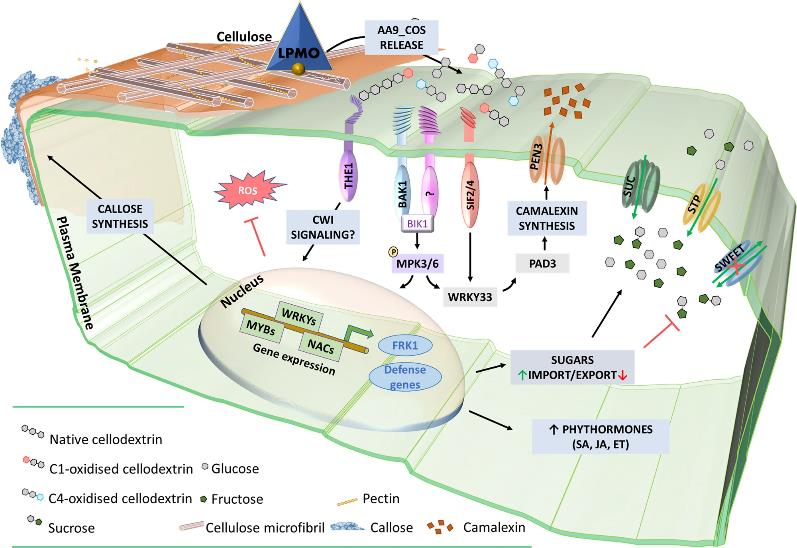Dans la même rubrique
-
Partager cette page
Cellulose Derived Biopesticide Activating the Plant Immune System [Offre de technologie]
The technology in a nutshell
Phytopharmaceutical compositions based on cellobionic acid to trigger plant defense responses, thus enhancing plant resistance to pathogens.
State of the art
The fight against plant pathogens is of key importance to guarantee food security and production and prevent economical losses worldwide. As of today, several conventional pesticides or fungicides are still used in agriculture. Such chemicals persist in our environment, enter the food supply chain and bioaccumulate in living organisms, leading to undesirable effects on human health and environment. In addition, biological resistance in plant pathogens is a growing concern. Therefore, there is an urgent need of developing new and environmentally friendly compoundsenabling pest control through alternative and sustainable mechanisms. In this context, the emerging class of natural molecules, able to activate the innate immune system of plants is quite appealing.
The invention
The present invention is directed to environmental-friendly phytopharmaceutical compounds and compositions triggering the innate defense of plants. The corresponding formulations of cellulose-derived oligosaccharides, including cellobionic acid, are obtained from bioresources such lignocellulose or paper waste enzymatically treated with lytic polysaccharide monooxygenases (LPMOs). Those compositions were shown to retard the infection and propagation of microbial pathogens such as the model necrotrophic fungus Botrytis cinerea, i.e. with a 60% infection symptoms reduction at high loads of pathogen. The corresponding plant transcriptomic responses were characterized in detail and confirmed that the compositions comprising cellobionic acid elicit the immune response of plants. Those phytopharmaceutical compositions provides means to boost plant natural defenses against pathogens, a central biological function common to many plants. These molecules have therefore the potential to be used as biopesticides for a broad range of crop species such as sugar beets, barley, wheat, tomato, grape and rice.
Key advantages of the technology
- For Bio-pesticide eliciting plant immune defenses providing enhanced resistance against pathogens including fungus B. cinerea and P. syringae
- Possible treatment of whole plants or crops seeds
- Eco-friendly phytopharmaceutical compositions sourced from lignocellulosic wastes.
Degradation of plant cell wall polysaccharides by microbial AA9-LPMOs enzymes leads to the release of native and oxidized cello-oligosaccharides, defined as AA9_COS. The recognition of AA9_COS in plants induces a deep transcriptional reprogramming associated with plant defense responses, including the phosphorylation of MPK3 and MPK6 and the synthesis of the antimicrobial molecule camalexin. Genes encoding for sugar transporters are also modulated by AA9_COS treatment, with the induction of cytoplasmic sugars import (SUC and STP) and the inhibition of SWEET transporters involved in sugar export from the cytoplasm to the apoplast.
Potential applications
- fungus Botrytis cinerea spread in grapevines, tomatoes, strawberries and sunflowers crops;
- bacteria Pseudomonas syringae on fruit trees.
Technology Readiness Level
*What's TRL?

TRL-3 Proof of concept of the technology in laboratory environment.
The team
The PhotoBioCatalysis (BioCat) research unit, led by D. Cannella is a interdisciplinarity laboratory conducting research spanning from the plant-cell wall and lignocellulose degradation to the valorization of the related products in form of sugar-based plant elicitor molecules, bioactive compounds, cellulose nanofibers, mycology, enzymology and biofuels processing. Light as a source of energy to drive catalytic degradation and signaling, at the fungi/plant interface is a key thematic of BioCat that enabled seminal discoveries on light activation of fungal oxidoreductases-LPMO (Cannella et al. Nat. Comm. 2016). BioCat and the Crop Nutrition research unit of the Bioengineer School of ULB have joined their respective expertises in 2019 through the creation of the Crop Production and Biostimulation Laboratory (CPBL) reinforcing thereby cross-disciplinarity approaches in this specific field of research within the University. Bio-Cat has in this framework set up a new platform for the production and characterization of several fungal redox enzymes involved in plant pathogenesis and extensively developed its know-how on plant pathogenesis and plant protection against biotic stresses. The CPBL benefits from state-of-the-art research infrastructures including plant growth facilities with controlled environment growth chambers amenable to different light regimes and a green-house surface of 300-600 sqm, plant physiology dedicated instruments, a fully dedicated laboratory for pathogenic and sporulating fungi studies as well as genetic and molecular biology, microbiology and analytical platforms.
The inventors
David CANNELLA is Professor at the Université libre de Bruxelles (ULB) since 2017 where he is heading the BioCat research unit embedded within the Crop Production and Biostimulation Laboratory. He is a specialist in plant-pathogen interactions and fungal Lytic Polysaccharide Monooxygenases (LPMOs) enzymes in this context. Before joining ULB, further to the grant of his PhD at the University of Copenhagen in 2014, he held positions as a post-doctoral fellow at this University in collaboration with Dong energy A/S biorefinery and as fellow of the Danish Research Council at La Sapienza Rome in the laboratory of Pr. F. Cervone, a prominent hub in plant immunity.
Marco ZARATTINI holds a PhD in Plant Biotechnology jointly awarded by the University of Ferrara and the University of Parma (Italy). He has extensive experience in innovative plant protection-technologies gained through research activities carried out both in agro-consortia Spin-Offs (Italy and Ecuador) and in top-level plant science research centers (INRAE, AgroParisTech, Institute Jean-Pierre Bourgin, France). Currently, he is a F.R.S.-FNRS postdoctoral researcher operating at the ULB.
Relevant publication
Keywords
- Pest Biocontrol
- Plant immunity Elicitor
- Pathoghens
- Botrytis Cinerea
- Pseudomonas. syringae
Collaboration type
- Licence agreement
- R&D&I collaboration
IP status
Main inventor
David CANNELLA
Marco ZARATTINI
Contact
ULB Research Department
Joachim Ruol
Business developer
+32 (0) 475 64 18 91
joachim.ruol@ulb.be

